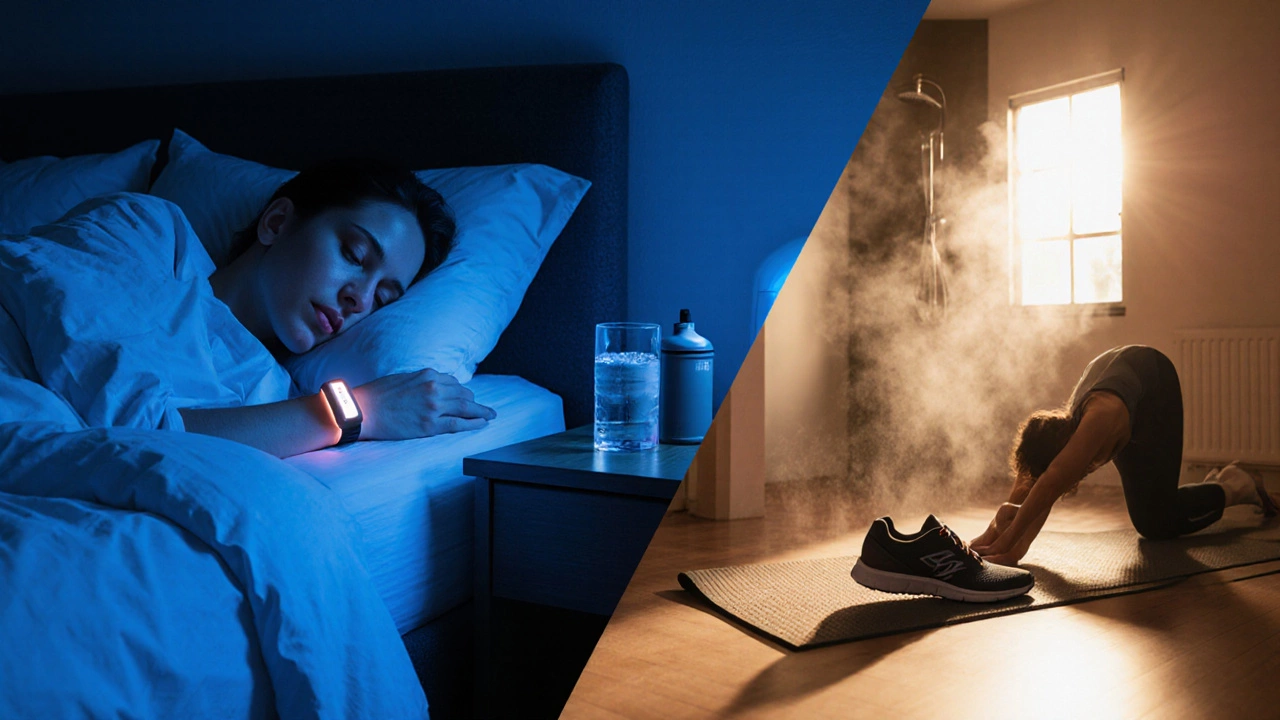Can You Safely Do HIIT Every Day? Risks, Benefits, and Expert Guidelines
 Oct, 8 2025
Oct, 8 2025
HIIT Frequency Checker
Check Your HIIT Schedule
Enter how often you do HIIT workouts and assess whether your routine is safe and sustainable.
Enter your HIIT frequency and duration, then click "Analyze My Routine" to get personalized feedback.
Feeling tired beyond 24-48 hours post-workout
Heart rate 5-10 bpm higher than usual
Soreness not improving with light movement
Plateau or decrease despite consistent effort
Key Takeaways
- Most research supports 3‑4 HIIT sessions per week for optimal gains and injury prevention.
- Daily HIIT can work if you vary intensity, keep sessions short, and prioritize recovery.
- Watch for warning signs like persistent fatigue, elevated resting heart rate, and chronic soreness.
- Use tools such as heart‑rate variability (HRV), adequate sleep, and balanced nutrition to support frequent training.
- Adjust your schedule based on personal fitness level, stress load, and how your body feels.
You've probably seen the hype: Instagrammers bragging about smashing a daily HIIT class, friends swearing by a 30‑minute burn every morning, and fitness ads promising "results in just 15 minutes a day." The question buzzing around the gym is simple-can you really do a HIIT class every day without hurting yourself? The answer isn’t black‑and‑white, but we can break it down with science, real‑world experience, and practical tips.
What Exactly Is HIIT?
When you hear HIIT is a training method that alternates short bursts of maximal effort with brief recovery periods, think of it as a sprint‑and‑walk pattern for your whole body. Typical intervals range from 20 seconds of all‑out effort to 2‑3 minutes, followed by equal or slightly longer rest. The whole session can fit into 10‑30 minutes, making it a time‑efficient cardio choice.
How Your Body Reacts to HIIT
During those explosive bursts, your cardiovascular system works to deliver oxygen to working muscles at a rapid rate pushes oxygen consumption close to its maximum-what scientists call VO₂max. Over weeks, regular HIIT can raise that ceiling, meaning you become more efficient at using oxygen during any activity.
At the muscle level, HIIT targets typeII muscle fibers the fast‑twitch fibers that generate power but fatigue quickly. Repeated high‑intensity bouts stimulate these fibers to become more oxidative, blurring the line between pure speed and endurance.
Metabolically, the effort drags your lactate threshold the intensity at which lactate accumulates faster than it can be cleared higher, so you can sustain harder work before feeling that burn.
But high stress also spikes cortisol the primary stress hormone released during intense exercise. A little cortisol helps mobilize energy, yet chronic elevation can blunt recovery, impair sleep, and even promote fat storage.

Warning Signs: When HIIT Turns Into Overtraining
Doing HIIT every day isn’t automatically a recipe for disaster, but ignore the body’s feedback at your peril. Look out for these red flags:
- Persistent fatigue that lasts beyond 24‑48hours.
- Elevated resting heart rate (by 5‑10bpm) or a noticeable dip in heart‑rate variability (HRV) the variation in time between heartbeats, a marker of recovery.
- Muscle soreness that doesn’t improve with light movement.
- Decreased motivation, mood swings, or trouble sleeping.
- Plateau or decline in performance despite “hard work.”
When several of these appear together, you’re likely slipping into overtraining syndrome a chronic imbalance between training stress and recovery. The safest move is to back off, prioritize recovery, and reassess your schedule.
What the Research Says About Frequency
Most peer‑reviewed studies converge on a sweet spot of 2‑4 HIIT sessions per week for healthy adults. For example, a 2023 meta‑analysis of 45 trials found that participants who performed HIIT three times weekly improved VO₂max by an average of 12% while keeping injury rates low (<2%). In contrast, protocols that pushed five‑plus sessions per week showed a spike in musculoskeletal complaints without additional cardio gains.
That doesn’t mean every person will react the same. Elite athletes, who have honed recovery systems over years, can tolerate near‑daily high‑intensity work-provided they meticulously periodize load and nutrition. For the average gym‑goer, 3‑4 sessions strikes a balance between progress and safety.
How to Make Daily HIIT Work (If You Really Want To)
If you’re set on a daily habit, think of “HIIT” not as a monolith but as a toolbox. Here are evidence‑backed strategies to keep the upside high and the downside low:
- Vary the intensity. Alternate between “hard” (90‑95% max heart rate) and “light” (60‑70% max) days. Light‑day sessions can be 10‑minute bodyweight circuits or bike sprints at a modest cadence.
- Shorten the intervals. On “daily” days, keep work periods under 30seconds and total session time under 15minutes. This reduces cumulative stress while preserving the metabolic spark.
- Switch modalities. Rotate between running, rowing, cycling, and bodyweight circuits. Different movement patterns distribute load across various muscle groups.
- Include active recovery. Use a yoga flow, light swim, or brisk walk on “recovery” days. The goal is blood flow, not extra fatigue.
- Track recovery metrics. Simple tools like a morning HRV reading, resting heart‑rate check, or a 5‑minute wellness questionnaire can tell you whether to push or pull.
- Prioritize sleep and nutrition. Aim for 7‑9hours of quality sleep and a post‑HIIT meal rich in protein (20‑30g) and carbohydrates (30‑50g) to refuel glycogen stores.
Sample Weekly Schedule
Below is a flexible template that lets you train almost every day while still honoring recovery. Adjust the numbers to match your fitness level and time constraints.
| Frequency | Typical Session Length | Key Benefits | Primary Risks | Recovery Strategies |
|---|---|---|---|---|
| 3‑4times/week | 20‑30min (full‑intensity) | Strong VO₂max gains, improved lactate threshold, low injury rate | Minimal if proper rest taken | Full rest days, balanced macros, 7‑9h sleep |
| 5‑7times/week (daily) | 10‑15min (short‑intensity or varied) | Maintains metabolic spike, habit formation | Higher cortisol, potential overtraining, joint stress | Active recovery, HRV monitoring, light‑day modulation |
Notice the shift in session length and the added emphasis on active recovery for the daily approach. The table isn’t a hard rule-think of it as a guide to help you design a plan that fits your life.

Recovery Toolbox: What to Do After Each Session
Recovery isn’t a passive state; it’s a set of actions that tell your body, "Okay, we’ve worked hard, now fix the damage." Here are the top five tools:
- Hydration. Replace the fluid lost through sweat. A good rule: 0.5L of water for every 30min of intense work.
- Protein. Consume 0.25‑0.30g protein per kilogram of body weight within 45minutes post‑HIIT to kick‑start muscle repair.
- Mobility work. Spend 5‑10minutes on dynamic stretches targeting hips, hamstrings, and shoulders to maintain range of motion.
- Sleep hygiene. Keep the bedroom cool, limit screens before bed, and aim for a consistent bedtime to improve both HRV and cortisol balance.
- Cold‑water or contrast showers. Short, 30‑second bursts can reduce perceived soreness and support circulation.
Who Should *Avoid* Daily HIIT?
Even with the smartest programming, some groups are better off limiting high‑intensity work to a few days a week:
- Beginners who haven’t built a solid aerobic base.
- People with uncontrolled hypertension, heart arrhythmias, or recent cardiac events.
- Those recovering from musculoskeletal injuries where repetitive high impact could worsen tissue damage.
- Individuals with high life‑stress levels (e.g., night shift workers) who already have elevated cortisol.
If any of these describe you, start with 2‑3 moderate sessions per week and gradually add intensity under professional guidance.
Bottom Line
Short answer: you *can* do a HIIT class every day, but only if you keep the sessions short, vary the load, and make recovery a non‑negotiable part of the routine. Most people will see better results-and stay healthier-by sticking to 3‑4 high‑quality sessions weekly and using the other days for active recovery or lighter cardio.
Frequently Asked Questions
Can I do a 30‑minute HIIT class every day?
A 30‑minute session at full intensity every day is usually too much for most people. It raises injury risk and may cause chronic fatigue. If you love a 30‑minute format, alternate hard days with light‑day versions that cut work intervals in half and keep intensity below 80% of max heart rate.
How many rest days should I schedule?
At least one full rest day per week is advisable. If you choose a daily HIIT schedule, insert two active‑recovery days (light cardio, yoga, or walking) to let your nervous system reset.
Is it okay to combine HIIT with strength training on the same day?
Yes, but plan the order wisely. If your goal is strength, lift first, then do a short HIIT finisher (5‑10minutes). For cardio‑focused goals, start with HIIT and keep the strength portion light.
What’s a safe heart‑rate zone for daily HIIT?
Aim for 80‑90% of your maximum heart rate during the work bursts. Use a simple formula (220‑age) for an estimate, or better yet, get a wearable that measures real‑time HR zones.
Will daily HIIT help me lose weight faster?
HIIT does boost calorie burn and post‑exercise oxygen consumption, but weight loss ultimately hinges on a consistent calorie deficit. Adding daily HIIT can accelerate the deficit, yet if it triggers overeating or poor sleep, the net effect may be neutral or negative.
